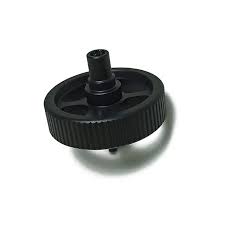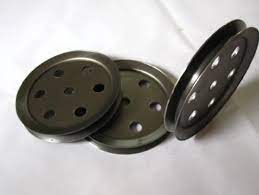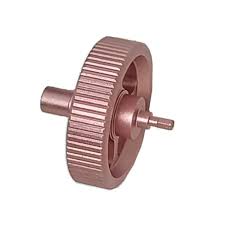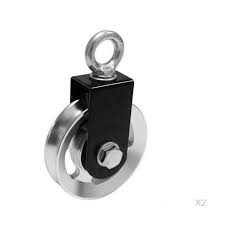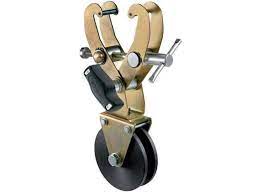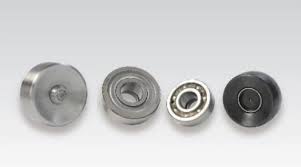Product Description
Agricultural Synchronous Aluminum Timing Spinning Taper Lock Bush Idler Flat Poly Grooved Sheave Wheel Adjustable Crankshaft Alternator Tension V Belt Pulley
Product Description
Pulleys belonging to wheel hub components are generally large in size, and their manufacturing processes are mainly casting and forging. Generally, the design with large size is cast iron (good casting performance), and cast steel is rarely used (poor casting performance); Generally, the smaller size can be designed as forgings and the material is steel. Belt pulley is mainly used for long-distance power transmission, such as the output of small diesel engines, agricultural vehicles, tractors, automobiles, mining machinery, mechanical processing equipment, textile machinery, packaging machinery, lathes, forging machines, power transmission of some small horsepower motorcycles, power transmission of agricultural machinery, air compressors, reducers, reducers, generators, cotton ginners, etc.
V-Belt Pulley:
The specifications of V-belts are divided by the dimensions of back width (top width) and height (thickness). According to different dimensions of back width (top width) and height (thickness), V-belts of different standards have different models. The pitch width, top width and height of V-belts of each model are different, so the pulley must also make various groove types according to the shape of V-belts; These different groove types determine various types of pulley.
| American Standard | |
AK/AKH BK/BKH TA/TB/TC Series Sheaves |
B/C/D Series Sheaves |
Poly-V Sheaves |
Variable Speed Sheaves |
| 3V/5V/8V sheaves | Bushings Split Taper Bushings/QD Bushings/TB Bushings |
European standard (SPA CHINAMFG SPC SPZ) |
|
Belt Pulleys for Taper Bushings |
V belt pulley with CHINAMFG hub |
Adjustable Speed V Belt Pulleys |
Flat Belt Pulleys For Taper Bushes |
Timing pulley:
The synchronous pulley drive is composed of a closed annular belt with equidistant teeth on the inner surface and corresponding pulley. When moving, the belt teeth mesh with the grooves of the belt pulley to transmit motion and power. It is a kind of meshing transmission, which has various characteristics of gear transmission, chain transmission and belt transmission. Widely used in automobile, textile, printing and packaging equipment, sewing equipment, office equipment, laser carving equipment, tobacco, financial machinery, stage lighting, communication and food machinery, medical machinery, steel machinery, petrochemical industry, instruments and meters, various precision machine tools and other fields
Spinning pulley:
Spinning is to fix the flat or hollow blank on the mold of the spinning machine. When the blank rotates with the main shaft of the machine, the blank is pressurized with a roller or driving rod to produce local plastic deformation. Spinning is a special forming method.
Agricultural pulley:
Agricultural pulley refers to the parts that can be used to repair and replace your agricultural machinery pulley, such as lawn mower and rotary tiller. Our agricultural pulley can perfectly replace various brands, including john deere
Custom pulley:
Bore type: pilot bore, finished bore, taper bore, bore for QD bushing.
Surface finish: Black oxide, phosphate, painted, Zinc plate, or passivated.
Material: 5C, cast iron, ductile iron, GG25, GGG40, nylon, aluminum, etc.
Inspection: Dynamic balance & Static balance tests are available with standardized design and well-equipped CNC Machining Systems.
Made according to drawings or samples, OEM inquiries are welcomed.
Related products
Company Profile
Production process
Certificates
/* January 22, 2571 19:08:37 */!function(){function s(e,r){var a,o={};try{e&&e.split(“,”).forEach(function(e,t){e&&(a=e.match(/(.*?):(.*)$/))&&1
| Certification: | CE, ISO |
|---|---|
| Pulley Sizes: | Type F |
| Manufacturing Process: | Forging |
| Material: | Carbon Steel |
| Surface Treatment: | Baking Paint |
| Application: | Chemical Industry, Grain Transport, Mining Transport, Power Plant |
| Samples: |
US$ 80/Piece
1 Piece(Min.Order) | |
|---|
| Customization: |
Available
| Customized Request |
|---|
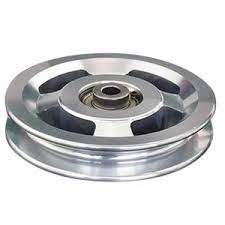
How do spinning pulleys impact the performance of fitness and exercise equipment?
Spinning pulleys play a significant role in enhancing the performance of fitness and exercise equipment. They contribute to the smooth operation, functionality, and effectiveness of various exercise machines. Here’s how spinning pulleys impact the performance of fitness and exercise equipment:
1. Resistance Adjustment:
In many fitness and exercise equipment, spinning pulleys are utilized to adjust the level of resistance. By incorporating pulleys of different sizes or changing the position of the pulley along the cable or resistance mechanism, users can modify the intensity of their workouts. This allows individuals to tailor their exercise routines to their fitness levels, goals, and preferences.
2. Smooth and Controlled Movement:
Spinning pulleys, combined with cables or belts, enable smooth and controlled movement in fitness equipment. They provide a stable and consistent motion, ensuring that users can perform exercises with proper form and technique. The smooth movement facilitated by spinning pulleys minimizes the risk of jerky or jarring motions, reducing the likelihood of injuries.
3. Multiple Exercise Options:
Fitness equipment often incorporates spinning pulleys to offer a wide range of exercise options. By utilizing pulleys with different cable attachment points and adjusting the cable paths, equipment manufacturers can provide users with versatile workout possibilities. Spinning pulleys enable exercises targeting different muscle groups, allowing users to perform various strength training or conditioning movements.
4. Cable and Handle Adjustments:
Spinning pulleys are instrumental in adjusting the length and position of cables or handles in fitness equipment. This adjustability allows users of different heights, body sizes, or exercise preferences to find the most comfortable and biomechanically suitable settings. Users can modify the range of motion and exercise angles to optimize their workouts.
5. Functional Training and Weight Stacks:
In weight training machines, spinning pulleys are used in conjunction with weight stacks to provide resistance. The weight stacks are connected to the pulleys, and the user pulls or pushes against the resistance. Spinning pulleys ensure smooth and even distribution of the weight load, enhancing the user’s ability to perform functional movements and isolate specific muscle groups.
6. Durability and Reliability:
High-quality spinning pulleys are crucial for the durability and reliability of fitness and exercise equipment. Pulleys designed to withstand the repetitive stresses and forces exerted during workouts ensure long-term performance and minimize the risk of component failures. Reliable spinning pulleys contribute to the overall safety and longevity of the equipment.
7. Maintenance Considerations:
Regular maintenance procedures, such as inspecting pulley systems, lubricating pulley bearings, and ensuring proper belt tension, are necessary to maintain the performance and functionality of fitness equipment with spinning pulleys. These maintenance practices help prevent premature wear, ensure smooth operation, and extend the lifespan of the equipment.
In summary, spinning pulleys significantly impact the performance of fitness and exercise equipment by enabling resistance adjustment, providing smooth and controlled movement, offering multiple exercise options, allowing cable and handle adjustments, facilitating functional training with weight stacks, ensuring durability and reliability, and requiring proper maintenance. These pulleys enhance the overall user experience, promote effective workouts, and contribute to achieving fitness goals in a safe and efficient manner.
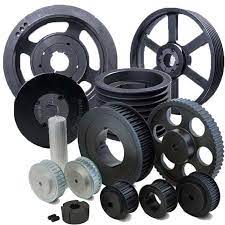
What are some real-world examples of spinning pulley applications in various industries?
Spinning pulleys find widespread applications in various industries, contributing to the smooth operation of different machines and systems. Here are some real-world examples of spinning pulley applications in various industries:
1. Manufacturing and Industrial Machinery:
– Conveyor Systems: Spinning pulleys are extensively used in conveyor systems across industries such as manufacturing, logistics, and mining. They help drive and guide conveyor belts, enabling the efficient movement of materials or products.
– Printing Presses: In the printing industry, spinning pulleys are crucial components in printing presses. They facilitate the movement of paper or printing substrates, ensuring precise registration and consistent printing quality.
– Machine Tools: Spinning pulleys are found in various machine tools like lathes, milling machines, and drill presses. They enable speed control and power transmission, allowing for different machining operations.
2. Automotive Industry:
– Engine Systems: Spinning pulleys are used in automotive engines to drive various components such as the alternator, water pump, power steering pump, and air conditioning compressor.
– Timing Systems: Timing pulleys and belts are employed in the engine’s timing system to synchronize the rotation of the camshaft and crankshaft, ensuring precise valve timing.
3. Textile Industry:
– Spinning and Weaving Machines: Spinning pulleys are integral to spinning and weaving machines in the textile industry. They facilitate the movement of fibers or yarns, ensuring proper tension and controlled feeding.
– Dyeing and Printing Machines: Spinning pulleys play a role in dyeing and printing machines by guiding fabrics through the dyeing or printing processes, ensuring accurate color application and pattern alignment.
4. Construction and Heavy Equipment:
– Cranes and Hoists: Rope pulleys, also known as sheaves, are used in cranes and hoists to provide mechanical advantage and facilitate lifting or load-bearing operations.
– Excavators and Loaders: Spinning pulleys are employed in construction equipment like excavators and loaders to transfer power and enable the movement of buckets or other attachments.
5. Agricultural Machinery:
– Harvesting Equipment: Spinning pulleys are used in agricultural machinery such as combine harvesters to drive components like the cutting platform or conveyor belts.
– Irrigation Systems: Pulleys are utilized in irrigation systems to drive pumps or control the movement of irrigation pipes or tubes.
6. HVAC Systems:
– Air Handling Units: Spinning pulleys are used in air handling units to drive fans and facilitate air circulation and ventilation.
– Cooling Towers: Pulleys are employed in cooling towers to drive the fan blades, promoting efficient cooling of water or other fluids.
These are just a few examples of spinning pulley applications in various industries. Spinning pulleys play a vital role in many other sectors, including mining, food processing, packaging, woodworking, and more. The versatility and functionality of spinning pulleys make them essential components in numerous machines and systems across different industries.
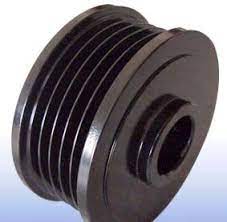
How does the rotation speed and diameter of a spinning pulley impact its performance?
The rotation speed and diameter of a spinning pulley have a significant impact on its performance. Let’s explore how these factors influence its operation:
1. Rotation Speed:
The rotation speed of a spinning pulley refers to the number of revolutions it makes per minute (RPM). The speed at which the pulley rotates affects the overall system performance in the following ways:
– Power Output: A higher rotation speed generally results in higher power output from the pulley. It allows for faster energy transfer and can be advantageous in applications where rapid operation or high-speed performance is required.
– Heat Generation: Increased rotation speed can lead to higher levels of heat generation due to friction between the pulley and the belt, rope, or cable. Proper cooling mechanisms or materials with high-temperature tolerance may be necessary to manage the heat effectively.
– Wear and Tear: Higher rotation speeds can accelerate the wear and tear of the pulley and the power transmission components. It may require more frequent maintenance and replacement of parts to ensure continued reliability and performance.
2. Diameter:
The diameter of a spinning pulley refers to the size of its cross-sectional circle. The diameter influences the performance of the pulley in the following ways:
– Torque Output: A larger pulley diameter allows for higher torque output. Torque is the rotational force exerted by the pulley, and a larger diameter pulley provides a mechanical advantage, enabling the transfer of more torque to driven components.
– Rotational Speed: A smaller pulley diameter results in higher rotational speed. It allows for faster rotational motion but typically reduces the torque output. Smaller diameter pulleys are suitable for applications that require high-speed operation with lower torque requirements.
– Belt Tension: The diameter of the pulley affects the tension of belts, ropes, or cables connected to it. Larger pulley diameters generally require less tension to achieve reliable power transmission, while smaller pulley diameters may necessitate higher tension to prevent slippage.
– Space Constraints: The physical dimensions of the spinning pulley, including its diameter, need to be considered in systems with limited space. Smaller diameter pulleys can be advantageous in compact designs where space is at a premium.
It’s crucial to strike a balance between rotation speed and diameter to achieve optimal performance and meet the specific requirements of the system. Designers and engineers carefully consider these factors to ensure efficient power transmission, longevity of components, and overall system reliability.


editor by CX
2024-05-16
